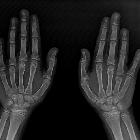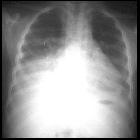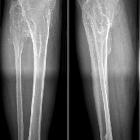Shortening of the fourth/fifth metacarpals/metatarsals

Positive
metacarpal sign • Positive metacarpal sign - Ganzer Fall bei Radiopaedia

Shortening of
the fourth/fifth metacarpals • Short 4th metacarpal - post-traumatic - Ganzer Fall bei Radiopaedia

Shortening of
the fourth/fifth metacarpals • Negative metacarpal sign - Ganzer Fall bei Radiopaedia

Positive
metacarpal sign • Short 4th and 5th metacarpals - Ganzer Fall bei Radiopaedia

Shortening of
the fourth/fifth metacarpals • Short 5th metacarpal - Ganzer Fall bei Radiopaedia

Madelung
deformity • Turner's syndrome - hand - Ganzer Fall bei Radiopaedia

Positive
metacarpal sign • Turner syndrome - hand - Ganzer Fall bei Radiopaedia

Shortening of
the fourth/fifth metacarpals • Bilateral short fifth metacarpals - Ganzer Fall bei Radiopaedia

Shortening of
the fourth/fifth metacarpals • Short fourth metacarpal - Ganzer Fall bei Radiopaedia

Shortening of
the fourth/fifth metacarpals • Short 4th/5th metacarpal - Ganzer Fall bei Radiopaedia

Shortening of
the fourth/fifth metacarpals • Short 5th metacarpal - Ganzer Fall bei Radiopaedia

Shortening of
the fourth/fifth metacarpals • Shortening of metacarpal bones - Ganzer Fall bei Radiopaedia

Shortening of
the fourth/fifth metacarpals • Short 5th metacarpal - Ganzer Fall bei Radiopaedia

Positive
metacarpal sign • Brachymetacarpia - Ganzer Fall bei Radiopaedia

Positive
metacarpal sign • Positive metacarpal sign - Ganzer Fall bei Radiopaedia

Brachydactyly
• Turner syndrome - short fourth and fifth metacarpals, brachydactyly & clinodactyly - Ganzer Fall bei Radiopaedia
Shortening of the fourth/fifth metacarpals and less commonly metatarsals is seen in a variety of apparently disparate conditions.
Pathology
Etiology
Common causes :
- idiopathic
- post-infective (e.g. osteomyelitis, yaws, tuberculosis dactylitis)
- pseudohypoparathyroidism/pseudopseudohypoparathyroidism
- post-traumatic (acute or chronic/healed and particularly those involving growth plate)
- Turner syndrome
Uncommon causes :
- basal cell nevus syndrome (Gorlin syndrome)
- hereditary multiple exostosis syndrome
- juvenile idiopathic arthritis
- sickle cell disease with secondary infarction
- homocystinuria
- Langer-Giedion syndrome
Isolated shortening of the 5metacarpals has been recently described in a familial variant of type 1 diabetes mellitus .
Radiographic features
Plain radiograph
Hand x-rays readily identify the abnormality and can be assessed by drawing a line along the heads of the 4 and 5 metacarpals. If this line intersects the head of the 3 metacarpal then shortening is deemed to be present.
Thus, shortened 4 metacarpal is the key to this finding. It is known as the metacarpal sign. It is important to note that a positive sign can be seen in up to 10% of normal individuals .
Siehe auch:

 Assoziationen und Differentialdiagnosen zu Verkürzung Metakarpale vier oder fünf:
Assoziationen und Differentialdiagnosen zu Verkürzung Metakarpale vier oder fünf:






